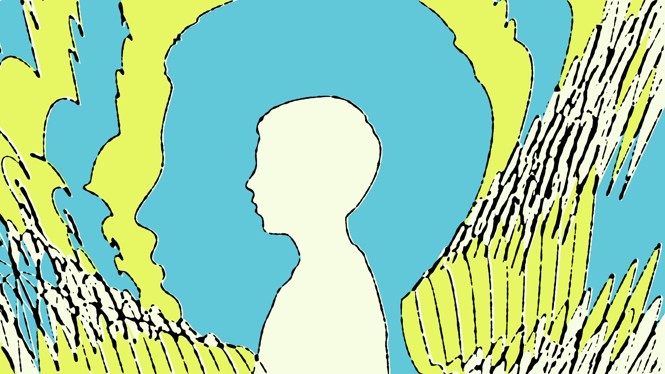This is an edition of the Books Briefing, our editors’ weekly guide to the best in books.
A panic attack can feel like the end of the world. In his new novel, Pan, Michael Clune writes that during such an episode, “your consciousness gets so strong it actually leaps out of your mind entirely. It starts vibrating your body. It shakes meat and bone.” My colleague Scott Stossel reviewed the book this week, writing that anxiety can make “rays of sunlight come through my eyes and get in my chest, and I feel like I’m gagging on them.” Your stomach might feel like it’s falling through the floor; your vision might blur; you might appear glassy, paralyzed by fear. Or, as in Lee Lai’s new graphic novel, Cannon, a panic attack might look like a menacing bunch of magpies piling up on furniture.
First, here are four new stories from The Atlantic’s Books section:
John Cheever’s secretsWhy Arundhati Roy fled literary fameA novel that helps explain the manosphere“Summertime,” a poem by Rosanna Warren
In Clune’s Pan, a teenage boy in the 1990s Chicago suburbs begins having debilitating panic attacks and seeks to make some kind of sense of them, researching the Greek god Pan, from whom the word panic is derived. Lai’s Cannon is very different stylistically, but it also attempts to communicate what panic feels like and how one might start learning to live with it. Its protagonist, Lucy, is a line cook in 2017 Montreal who manages her anxiety by running and biking while listening to soothing self-help tapes that remind her to focus on her breathing. Her best friend, Trish, calls her “Luce Cannon” (Cannon for short) as a joke: She’s known to be steady, reliable, and contemplative. But underneath her chill facade, Cannon’s about to blow her lid. She’s taking care of her ill-tempered grandfather almost single-handedly, she’s trying to ward off her jerk boss’s innuendos without losing her job, and she believes that Trish takes her friendship (and her time) for granted.
The comic focuses on Cannon, but readers don’t get to access her internal monologue. Mostly, we have to guess her state of mind based on her body language, her actions, and her words. The biggest hint we get is the birds: Magpies hop on her bike, shed feathers in her apartment, and hop around her grandfather’s kitchen. None of the characters, save Cannon, seems to see them. But they’re harbingers of an event that’s depicted in the book’s first panels: Cannon and Trish sit in the ruins of a darkened, wrecked restaurant, birds perched calmly around them. After this flash-forward, the narrative goes back three months, and we watch Cannon get closer and closer to that pivotal moment; all the while, the flock of magpies grows.
Despite its knotty subject, Cannon is a joy to read. Its art manages to be both spare and full of emotion; its dialogue feels lived-in. And it’s a cathartic, unexpectedly gleeful story about anxiety. For years, Cannon bottles up all her fears. But as the early scene in the restaurant shows, that’s not sustainable. When she explodes, she’s on the verge of a panic attack. Instead of turning her worries inward, however, she transmutes them into rage, smashing dishware and overturning tables. The birds triumphantly swoop around with her, diving and flapping across the pages. Afterward, the magpies aren’t gone—there’s still plenty of stress on her plate—but Cannon finds it a bit easier to breathe.
 Ben Kothe / The Atlantic
Ben Kothe / The Atlantic
Panic Attacks and the Meaning of Life
By Scott Stossel
A new novel keenly describes the symptoms—and more important, the existential stakes—of extreme anxiety.
What to Read
Room Temperature, by Nicholson Baker
Baker is best known for his experimental debut novel, The Mezzanine, which takes place largely during a single ride up an escalator. In this, Baker’s second novel, the author brings the same level of detail to a—only slightly—longer stretch of activity: a father feeding his newborn daughter. Giving the baby a bottle constitutes the surface-level action of the novel while the narration acts like a boomerang, flying past and returning to meditations on the narrator’s bond with his wife, Patty. Their partnership is generous and kind. They make up quickly after fighting; they playfully tease each other; they comfort each other—such as when the narrator reassures Patty after she’s criticized for her terrible spelling. Baker perfectly captures the intimacy of everyday love. A late chapter in the book detailing the couple’s euphemism for defecating—big jobs—and how the phrase takes its place in their personal lexicon is unexpectedly moving, a testament to how the most mundane parts of a shared life can be the most profound. Room Temperature is a book in which not much happens, and everything happens—a fitting description for an excellent marriage. — Isle McElroy
From our list: Seven books that explore how marriage really works
Out Next Week
📚 Replaceable You, by Mary Roach
📚 Boy From the North Country, by Sam Sussman
📚 The Wilderness, by Angela Flournoy
Your Weekend Read
 Illustration by The Atlantic. Source: Getty.
Illustration by The Atlantic. Source: Getty.
Are Humans Watching Animals Too Closely?
By Ross Andersen
We are not great respecters of boundaries, human beings. Dogs may not have known this about us when they first edged up to our campfires, more than 10,000 years ago. They could not have anticipated the degree to which we would dictate the most intimate parts of their lives, up to and including their sexual partners. Even after these dramatic interventions, which we have used to cultivate in dogs a preference for captivity, we still have to exercise a lot of coercion in order to get them to play along. We have to remove them from their mother while they are still young. We have to keep them behind locked doors and gates, and on leashes.
When you buy a book using a link in this newsletter, we receive a commission. Thank you for supporting The Atlantic*.*
Sign up for The Wonder Reader, a Saturday newsletter in which our editors recommend stories to spark your curiosity and fill you with delight.
Explore all of our newsletters.
From The Atlantic via this RSS feed


